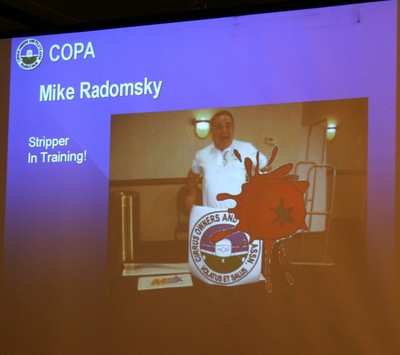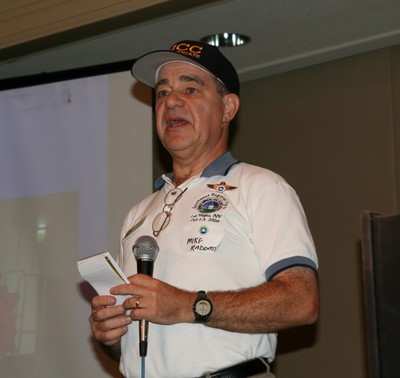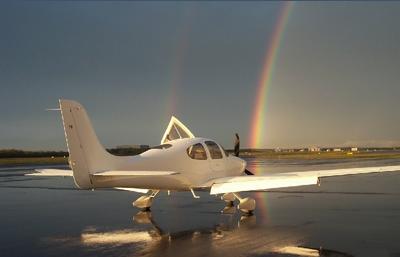A Top-Notch Owner's Club Meets At AOPA Expo
by ANN Associate Editor Mark Sletten
 Members of the Cirrus
Owner's and Pilot's Association (COPA) held their annual
meeting during AOPA Expo this year in Palm Springs, CA. Hosted
by association President Mike Radomsky and Vice-president Gordon
Feingold, the meeting included a presentation by Cirrus CEO Alan
Klapmeier and Cirrus president David Coleal. ANN was offered an
invitation to attend the meeting. Simply put, we observed an
owner's group par excellence - an example of involvement in the
promotion of airmanship and safety that all of general aviation
should strive to emulate.
Members of the Cirrus
Owner's and Pilot's Association (COPA) held their annual
meeting during AOPA Expo this year in Palm Springs, CA. Hosted
by association President Mike Radomsky and Vice-president Gordon
Feingold, the meeting included a presentation by Cirrus CEO Alan
Klapmeier and Cirrus president David Coleal. ANN was offered an
invitation to attend the meeting. Simply put, we observed an
owner's group par excellence - an example of involvement in the
promotion of airmanship and safety that all of general aviation
should strive to emulate.
Sometimes formal, sometimes relaxed, sometimes serious,
sometimes whimsical; this association's leadership likes to keep
attendees informed and entertained. The 2300-member association
celebrated its fifth birthday during the meeting, and Radomsky
kicked off the cake cutting ceremony by launching a small
radio-controlled helicopter from atop the cake, flying it about the
room to laughter and applause, then crashing… ahem, excuse
me, "landing" the toy back on the cake.

The leadership obviously likes to keep the atmosphere
light-hearted, but the entertaining banter so skillfully blended
with nuggets of wisdom and caution forms a potent brew. Like a fine
Cabernet having the sweet tastes of cherry and vanilla mixed with
just the right amount of bite, the setting was fun with a deadly
undertone -- the perfect approach to instill and foster the "safety
culture" all members live and breathe.

What is a safety culture? It's an aviation way of life; where
safety is paramount not only in word, but also in deed. When a
member of COPA tells you safety is THE overriding concern for ALL
of his or her flights, you can be sure you're not just receiving
lip service -- you're speaking to a believer.
COPA, more than anything else, is an information clearing house
for its members. The association publishes a monthly news magazine
rivaling the industry's best in its depth, quality and class. It
maintains an up-to-date website chock full of pertinent information
like an event calendar, membership data, a photo gallery, weather,
member stories, etc. Those alone would be worth the annual $50
membership dues, but in addition the association manages an
electronic forum where members can communicate directly with one
another via the internet. Best of all, using the forums, members
can choose to post publicly so ALL may read, think and comment.
The association's leadership believes the forums are key to
COPA's safety culture. Indeed, even Alan Klapmeier thinks
information shared between members is critical. "Conversation about
safety is essential," he said during his presentation to the
members. "Training isn't the answer - awareness is. Anyone can
operate the controls competently, it's the decisions we make that
determine the outcome of the flight."

The forums aren't just a way to find a good place to get a $100
hamburger, although they're good for that too! And they're not just
a place to discuss the latest boneheaded mistake, although that too
is valuable. In fact, the members not only dissect accident
histories, they also discuss NON-accidents.

Listen To ANN's Interview With Alan Klapmeier About The Culture
Of Safety Here
Radomsky (pictured below) told ANN about a recent discussion on
the forums where a member posted he had found the weather a bit
dicey for a planned flight. He publicly related all of the
parameters: current and forecast weather, who was on the plane, how
much rest he'd had, the reason for the flight, the condition of the
plane, his proficiency, etc., and how all of it added up to a
decision to cancel the flight. Throughout the discussion, other
members posted their opinions and reasons why they might have made
a different decision, but all expressed unanimous support for the
original pilot's decision to abort the flight. That's a safety
culture.

The association doesn't just leave it up to its members to keep
the information ball rolling. It's developed several programs
designed to propagate and cultivate a safety mindset in all those
who wish to participate. The Cirrus Pilot Proficiency Program
(CPPP) is a two-part, ground and flight training program all
members are encouraged to attend annually. Subjects discussed
include normal and emergency procedures, weather, advanced
avionics, maintenance and single-pilot resource management. The
flight portion is nothing short of an intense biennial flight
review -- you know… the kind your local FAA flight examiner
might give?
During the meeting, Feingold (pictured below) shared CPPP
attendance statistics. Cirrus enjoyed a 20-percent growth in its
fleet last year, but attendance at CPPP seminars grew by only
7-percent. Just as a smart pilot always reviews his performance and
looks for ways to improve, COPA as an organization isn't shy about
pointing out its own flaws. This one observation should tell you a
great deal about the association.

In keeping with Klapmeier's belief that decisions drive safety,
COPA also hosts a Cirrus-sponsored seminar on Critical
Decision-Making (CDM). COPA members attending the CDM seminar
participate in discussions on key safety topics. Cirrus factory
pilots maintain a higher than average safety record and they share
their observations and techniques with attendees. Also of note to
COPA is the difference between currency and proficiency. Seminar
leaders help attendees understand how to evaluate their own
proficiency and factor it in decisions relating to personal
minimums. Cirrus' Klapmeier believes so strongly in the CDM
program, the company makes them free to attend -- all you have to
do is get yourself there. Cirrus even pays for lunch!
COPA publishes a document it calls a "Code of Conduct." If one
document could embody the COPA safety culture this would be it. In
COPA's own words, the Code provides a set of guidelines helping
pilots improve their airmanship, flight safety, and to sustain and
improve GA. The Code presents a vision of excellence in GA. Its
principles both complement and supplement what is merely legal.

COPA credits Michael Baum as the vision and motivation behind
the Code. In the document he outlines principals, an explanation of
and sample recommended practices for each of six topics:
- General Responsibilities of Aviators
- Passengers and People on the Surface
- Training and Proficiency
- Security
- Environmental Issues
- Use of Technology
ANN encourages each GA pilot reading this to download the Code
from COPA's website (it's free) and thoroughly read and understand
it. You won't find a finer guide to help you improve your
airmanship, your awareness of safety and your relationship with the
non-flying world.
Radomsky took a few moments to discuss some very interesting
statistics. COPA reviewed the fatal-accident history of Cirrus
aircraft and discovered a remarkable correlation: COPA members were
involved in only three of twenty-three fatal accidents. Radomsky
estimates you are 15 - 18 times more likely to be involved in a
fatal Cirrus accident if you are not a COPA member.

You might think (I did at first) this sounds like a really bad
way to shill for membership, but you would be very wrong. COPA
leadership shares these numbers with its membership, but you won't
see them anywhere in the public area of its website -- neither are
they in literature promoting membership. Remember, ANN was
attending an annual meeting of members, not a membership drive.
COPA presents data like this to members as part of that safety
culture. A safety mindset feeds and grows on success, and these
numbers validate COPA members' efforts to follow membership
guidelines and promote safety in the organization.
ANN asked Radomsky and Feingold if COPA has approached insurers
with these incredible stats to get a break for COPA members on
premiums. It's something COPA has considered with very mixed
feelings. COPA is extremely (and rightfully) proud of its
membership. Offering an insurance break would make for a monetary
incentive to join COPA, and that worries Radomsky and Feingold.
COPA wants members who wish to be part of its safety culture;
members who will be involved, attend seminars, join the forum
discussions and take an active part in the association. Radomsky
and Feingold believe that's the kind of pilot responsible for
COPA's extraordinary safety record, and they don't want to dilute
the gene pool so to speak.

And speaking of active membership -- COPA is in the early
planning stages of implementing a "buddy system." While the forums
provide a great way for members to discuss situations after the
fact, it doesn't help a pilot trying to make a good decision at the
time of a flight. COPA's buddy system would provide members with
contact information for experienced volunteer pilots to act as a
sounding board for a pilot struggling with a decision. Radomsky
says Flight Service Station briefers are a great resource, but
sometimes a pilot needs to talk to another pilot who's been there,
done that.
ANN has written about COPA
before -- we were thoroughly wowed then, and nothing
has changed since. This association continues to evolve and grow
into a leading role in the GA community. If you own a Cirrus
aircraft and you aren't a member of COPA, you might want to stop
and consider why. COPA can help you learn more about your Cirrus
aircraft, yourself and managing the risks of GA flying -- and
you'll have fun doing it!
 ANN's Daily Aero-Linx (04.15.24)
ANN's Daily Aero-Linx (04.15.24) Classic Aero-TV: 'No Other Options' -- The Israeli Air Force's Danny Shapira
Classic Aero-TV: 'No Other Options' -- The Israeli Air Force's Danny Shapira Aero-News: Quote of the Day (04.15.24)
Aero-News: Quote of the Day (04.15.24) Airborne 04.16.24: RV Update, Affordable Flying Expo, Diamond Lil
Airborne 04.16.24: RV Update, Affordable Flying Expo, Diamond Lil ANN's Daily Aero-Term (04.16.24): Chart Supplement US
ANN's Daily Aero-Term (04.16.24): Chart Supplement US











